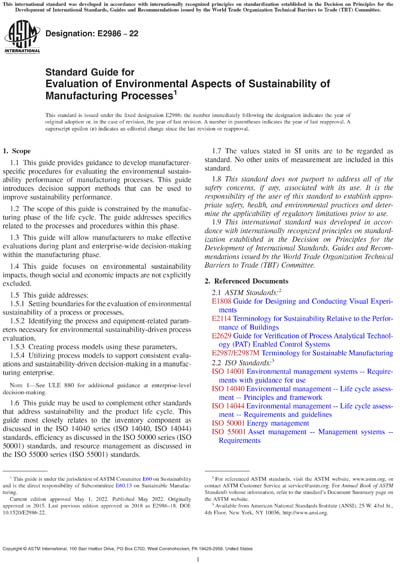Most recent
ASTM E2986-22
Standard Guide for Evaluation of Environmental Aspects of Sustainability of Manufacturing Processes
1.1This guide provides guidance to develop manufacturer-specific procedures for evaluating the environmental sustainability performance of manufacturing processes. This guide introduces decision support methods that can be used to improve sustainability performance.
1.2The scope of this guide is constrained by the manufacturing phase of the life cycle. The guide addresses specifics related to the processes and procedures within this phase.
1.3This guide will allow manufacturers to make effective evaluations during plant and enterprise-wide decision-making within the manufacturing phase.
1.4This guide focuses on environmental sustainability impacts, though social and economic impacts are not explicitly excluded.
1.5This guide addresses:
1.5.1Setting boundaries for the evaluation of environmental sustainability of a process or processes,
1.5.2Identifying the process and equipment-related parameters necessary for environmental sustainability-driven process evaluation,
1.5.3Creating process models using these parameters,
1.5.4Utilizing process models to support consistent evaluations and sustainability-driven decision-making in a manufacturing enterprise.
Note 1:See ULE 880 for additional guidance at enterprise-level decision-making.
1.6This guide may be used to complement other standards that address sustainability and the product life cycle. This guide most closely relates to the inventory component as discussed in the ISO 14040 series (ISO 14040, ISO 14044) standards, efficiency as discussed in the ISO 50000 series (ISO 50001) standards, and resource management as discussed in the ISO 55000 series (ISO 55001) standards.
1.7The values stated in SI units are to be regarded as standard. No other units of measurement are included in this standard.
1.8This standard does not purport to address all of the safety concerns, if any, associated with its use. It is the responsibility of the user of this standard to establish appropriate safety, health, and environmental practices and determine the applicability of regulatory limitations prior to use.
1.9This international standard was developed in accordance with internationally recognized principles on standardization established in the Decision on Principles for the Development of International Standards, Guides and Recommendations issued by the World Trade Organization Technical Barriers to Trade (TBT) Committee.
ASTM International [astm]

